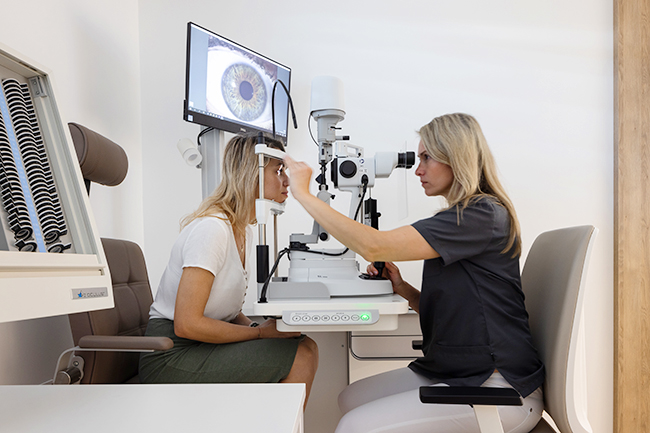Imagine life without glasses or contact lenses. No more squinting to try and recognise people’s faces, no more eyes burning from contact lenses, no more searching for lost glasses. Get a taste of freedom with quick, painless laser eye surgery at IVIO Clinic.
State-of-the-art lasers make it possible to gently and quickly remove all standard refractive errors such as short-sightedness and long-sightedness, including in combination with astigmatism. Our clients can get rid of their glasses and contact lenses via an array of methods using the Mel 90 excimer laser and/or the Visumax femtosecond laser. The doctor will decide on the best method based on the preoperative evaluation.
What you should know about laser eye surgery
What to expect
- After the patient registers at reception, several painless instrumental measurements are made that provide the surgeon with important information about the condition of the patient's eyes and their refractive error. This includes measuring the patient’s dioptre and intraocular pressure.
- This is followed by an evaluation by a specialised eye doctor, who assesses the instrument readings and performs an eye exam. The patient is welcome to ask or request information about anything that interests them regarding the procedure.
- Next, after consultation with the doctor, the nurses will come in to prepare the patient for the operation. This includes numbing the eyes. Since the procedure is conducted under local (topical) anaesthesia, eye drops are used as the anaesthetic. A nurse or doctor will describe to the patient what will happen during the operation.
- If possible, we recommend keeping your eyes closed on the first day to help heal your eyes.
- It is essential to follow the instructions for applying the recommended therapy and to appear for scheduled post-operative follow ups.
- Patients should wear sunglasses for the first few days after the operation.
- For the first two weeks after the operation, we recommend not wearing make-up and avoiding dusty and smoky areas, swimming pools, saunas, and sunbeds.
- During the first month, every client should eliminate any risk of injury to the eyes (such as by avoiding contact or adrenalin sports).
Three basic laser eye surgery methods at IVIO Clinic


SURFACE PRO
Surface Pro surgery uses a Mel 90 excimer laser manufactured by Zeiss, one of the world’s leading optics companies. In this method, an alcohol solution is applied to loosen the corneal epithelium over the operated zone. The epithelium is then lifted and excimer laser ablation is performed, correcting the refractive error. The epithelium is then placed back and a protective contact lens is applied, which is left in place for four days.
Restoration of vision after the Surface Pro procedure generally takes longer than for other procedures and may be accompanied by feelings of discomfort. Although there are other recognised laser techniques for vision correction, today Surface Pro is viewed as a good value solution.
This technique can be used to correct short-sightedness, long-sightedness, and astigmatism.
FEMTO LASIK
Femto-LASIK operations are performed using two types of lasers – a Visumax femtosecond laser and a Mel 90 excimer laser from Zeiss. The femtosecond laser is used to create a superficial flap in the cornea, which is lifted. The excimer laser is then then used to perform laser ablation at the site of the exposed flap, correcting the refractive error. At the end of the operation, the flap is returned to its original position.
Femto-LASIK is the most advanced form of this lamellar procedure and is largely used around the world. Recovery and vision improvement tend to be very quick and minimally painful. After the operation, patients only rarely experience side effects associated with the procedure. However, when compared to the newest technique, ReLEx SMILE, some studies have reported a higher incidence of dry eye disease.
This technique can be used to correct short-sightedness, long-sightedness, and astigmatism.
Relex SMILE
The Relex SMILE technique is a minimally invasive therapy which, unlike the previous methods, does not require the creation of a flap. Using a femtosecond laser, a thin corneal tissue called a lenticule is created and a small incision made inside the cornea. In the next stage of the operation, the lenticule is extracted from the inside of the cornea through this small incision. The removal of the lenticule changes the corneal curvature, thereby achieving the desired refractive error correction.
Relex SMILE is the newest and most advanced technique available. It is minimally invasive and the cornea heals quickly. Compared with other methods, this technique involves the least cutting into the surface of the cornea and the lowest incidence of dry eye symptoms in the immediate post-operative period.
This technique can be used to correct short-sightedness and astigmatism.
|
Laser eye surgery price list – vision correction up to age 40 (price per eye)
|
Insured
|
Self-payer
|
|
SURFACE
|
350 €
|
350 €
|
|
SURFACE PRO
|
515 €
|
515 €
|
|
Femto-LASIK
|
515 €
|
515 €
|
|
Relex SMILE
|
850 €
|
850 €
|
|
Additional correction
|
300 €
|
300 €
|
|
Prices are valid from 15 november 2023 |
||
